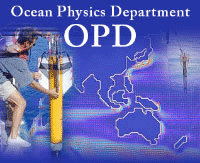


Mike Gregg
Principal Investigator
Matthew Alford
Co-Principal Investigator
Ren-Chieh Lien
Co-Principal Investigator
Glenn Carter
Principal Investigator
Univ. of Hawaii, Manoa
Dave Winkel
Oceanographer
Danielle Wain
Postdoctoral Researcher
Univ. of Washington
Rob Hall
Postdoctoral Researcher
Univ. of Hawaii, Manoa

NSF
OCE 07501420
OCE 0751226
|
|
GOALS & OBJECTIVES
The research program in the Monterey Submarine Canyon combines modelling and intensive observations as well as exploration of nearby Ascension Canyon.
|
|
Our goals:
- Understand how the internal tide propagates in canyons, and in particular how the M2 energy flux is steered around bends and where turns are so sharp that the energy is dissipated
- Determine whether mixing locations and levels can be predicted by convergences in the along-canyon M2 energy flux
- Identify and quantify mixing produced by internal wave scattering, lee waves and hydraulic jumps
- Assess the effects that canyon shape, smoothness and alignment with offshore M2 sources have on mixing and baroclinic energy by measuring mixing and the internal tide in a relatively short, straight canyon ending on the outer shelf
Our specific objectives:
- Understand how much M2 energy in Monterey Canyon comes from offshore vs. internal generation
- Understand how the internal tide propagates around bends
- Understand why the internal tide in Monterey Canyon sometimes produces standing instead of propagating waves
- Quantify the mixing and parameters of mechanisms producting it, e.g., scattering lee waves and jumps
- Measure the internal tide flux into the nearby Ascension Canyon and identify and quantify mixing along the canyon's axis
|
|

|

|
Science party. Standing, left to right: Danielle Wain, Andrew Cookson, Glenn Carter, John Mickett, Dave Winkel, Steve Bayer, Jack Miller, Rob Hall, Paul Aguilar, and Ren-Chieh Lien. Sitting: Matthew Alford. Kneeling: Mike Gregg.
|
|
|
|



